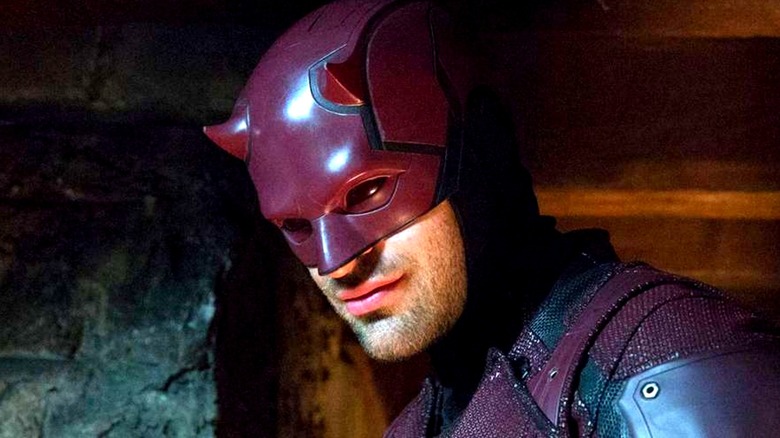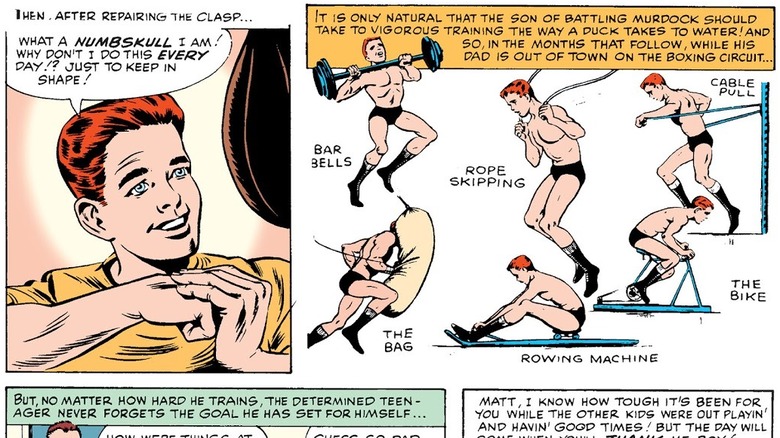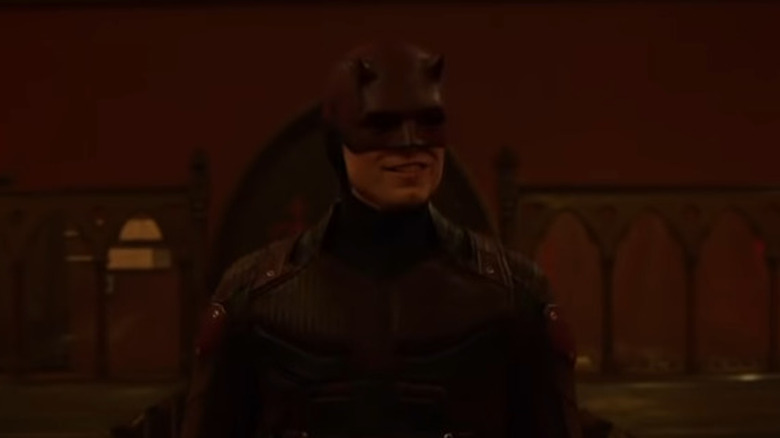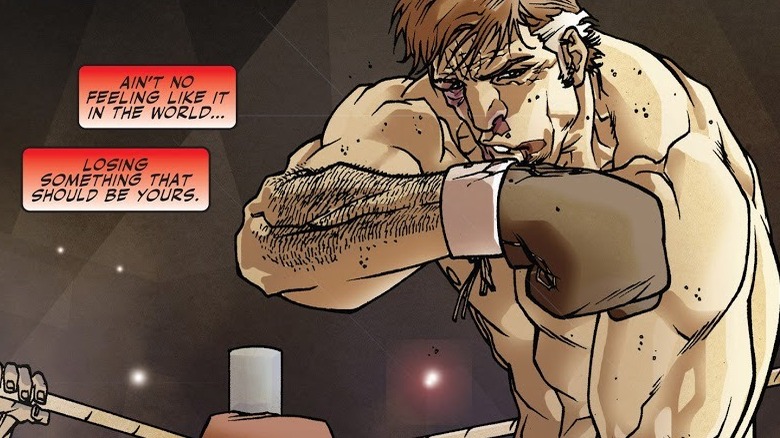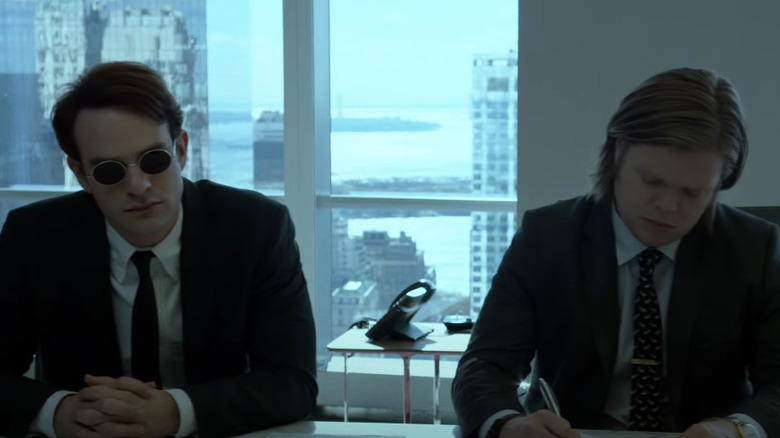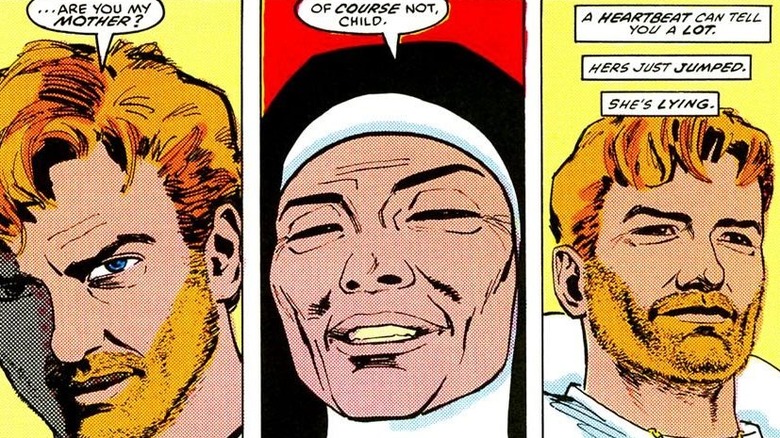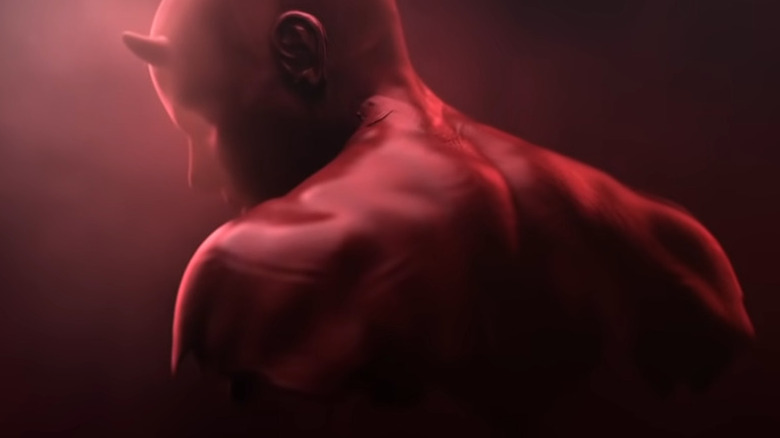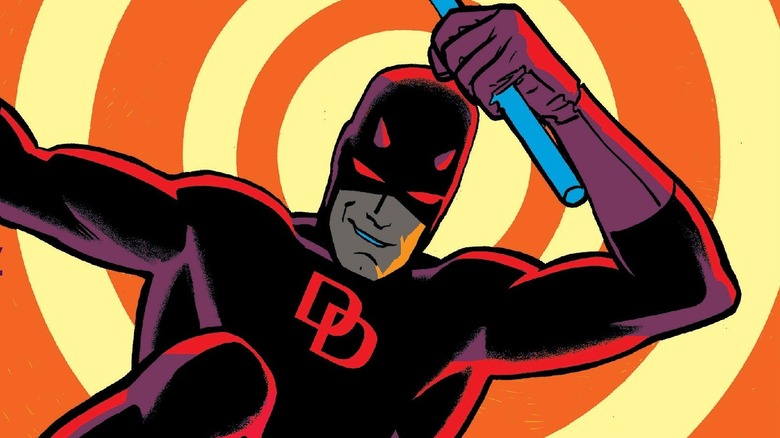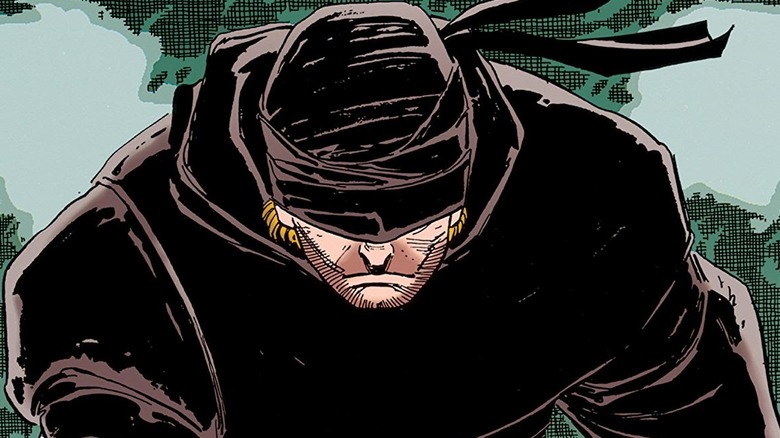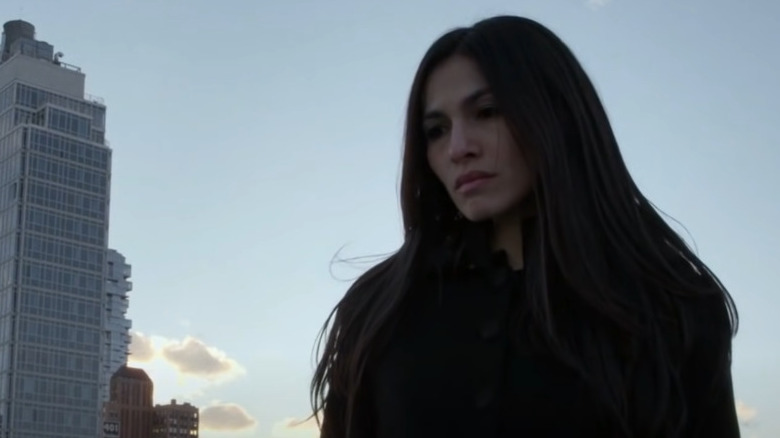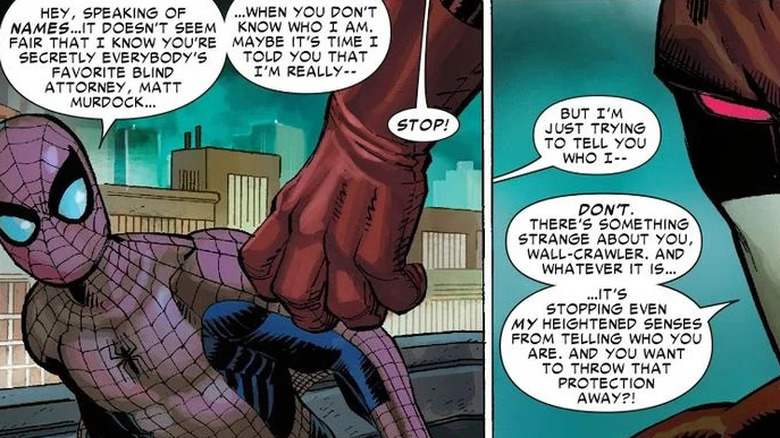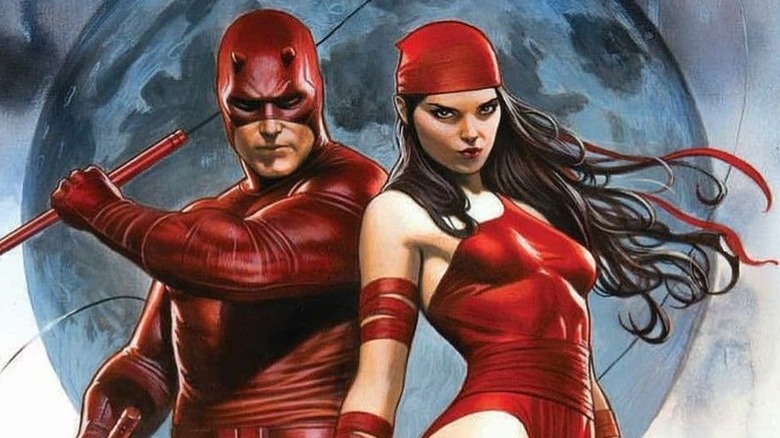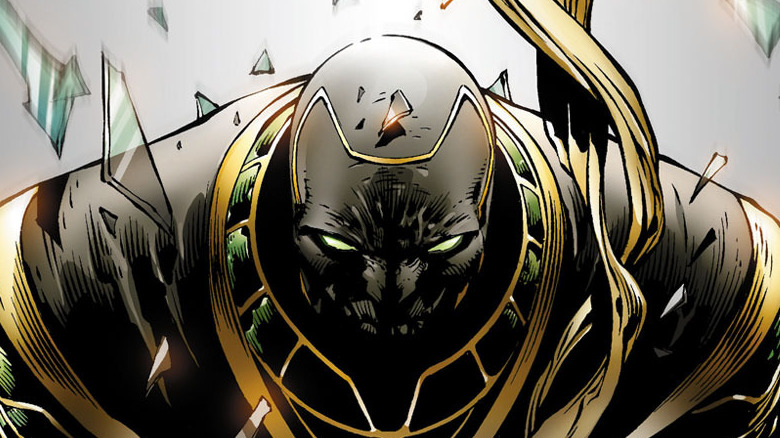All The Ways Marvel Lied To You About Daredevil
One of the problems inherent to serialized fiction — especially for any work that has been going on for an extended period of time — is the high chance of inconsistencies and continuity errors occurring in the over-arching narrative. This is particularly evident in the realm of superhero comic books. Whether due to editorial mandates or a case of too many "cooks" (writers, artists, and editors), long-running characters are bound to have some conflicting details about their histories, powers, etc. when examined in hindsight.
Take Daredevil, for example. Throughout his decades-long publication history, the details about his origins and who he is as a character have largely remained the same: blinded in an accident after a selfless act, the Man Without Fear operates both within the law and outside its boundaries to punish evildoers and obtain justice for their victims. However, as a result of so many creative minds contributing to Daredevil's ongoing story, there are some aspects of his life that don't seem to add up. And no, we're not talking about his numerous relationships or various team affiliations; we mean things as basic and fundamental as when he actually started his costumed vigilante career, or the effectiveness of his super-powers.
These are some of the most confusing and misleading details about Daredevil and his world, both from the comics and the live-action series — mistakes and contradictions so blatant, not even a lawyer as skilled as Matt Murdock could help Marvel talk its way out of them.
Daredevil went from being self-taught to being ninja-trained
While Daredevil has an impressive array of superhuman abilities, those alone wouldn't be enough to make him an effective (or still-breathing) superhero. Logically, he would have had to learn how to harness his incredible talents, as well as pick up some fighting skills along the way. But how exactly did he train to become a fearless crime-fighter?
Comic readers first got a glimpse of the Devil of Hell's Kitchen in 1964's "Daredevil" vol. 1 #1. That issue introduces Matt Murdock, the son of an aging boxer named Jack Murdock. As the older Murdock encourages his son to stick to studying and avoid following in his footsteps, Matt decides to secretly train himself to fight back against his bullies. After saving an old man from being hit by a truck, Matt's eyes are permanently injured by the vehicle's radioactive cargo. The young boy soon discovers that in losing his sight, his other senses have been significantly amplified. He proceeds to continue his secret training, and it is implied that he learned how to harness his abilities on his own.
That is, until Frank Miller's 1993 limited series "Daredevil: The Man Without Fear" reveals that Matt actually had a little help. In this now-canon retelling of Daredevil's origin, a blind martial artist named Stick (who debuted years earlier in "Daredevil" vol. 1 #176) is shown to have helped Matt significantly in mastering strange new gifts after his accident.
Netflix Daredevil's greatest villain was hinted at... and then introduced as someone else
Initially streamed on Netflix for years before finding a new home in Disney+, the "Daredevil" series was widely regarded by fans and critics alike as one of the better projects to come out of the Netflix-Marvel collaboration. The show ran for three seasons, covering much of the titular hero's iconic characters and settings. Season 3 in particular featured the official introduction of the murderous and impossibly precise marksman known as Bullseye, a man many consider to be Daredevil's most deadly foe. Or did it?
In the sixth episode of the first season, there was a scene that seemingly hinted at the legendary assassin's existence in this version of Daredevil's world. Eagle-eyed fans took note of a particularly skilled sniper under the payroll of the Kingpin (Vincent D'Onofrio). A playing card was visible in the sharpshooter's bag, and to viewers who caught this little Easter egg, it seemed like confirmation that this individual was indeed Bullseye. After all, the character does have a reputation in the comics as a deadly mercenary, and he has worked with the crime lord on numerous occasions.
However, this apparent hint would ultimately go nowhere, as the third season instead focused on the dangerous, mentally-troubled FBI agent Benjamin Poindexter (Wilson Bethel), the series' "true" Bullseye. Depicted to be every bit as dangerous as his comic counterpart, he suits up as Daredevil at the Kingpin's behest to frame the superhero.
Daredevil had a great dad ... who actually wasn't so great
In mainstream interpretations of Daredevil's origin story, it is the death of his father, former boxing superstar "Battlin'" Jack Murdock, which customarily pushes Matt to suit up and take the law into his own hands. Over the years, however, there were a couple of small yet significant changes to Jack that cast Matt's dual life as legal eagle and costumed crime-fighter in a different light.
In "Daredevil" vol. 1 #1, Jack is a gentle and caring single parent, guiding his son toward being studious and living a life far from violence. Unfortunately, Jack meets a gruesome end after refusing to fake defeat during a critical match. In this version of the story, his death takes place during Matt's years in law school. After setting up his own law firm with his best friend Foggy Nelson, Matt dons his horned cowl for the first time in an effort to find his father's killers.
However, two limited series added a few tweaks to Jack's story. In 1993's "Daredevil: The Man Without Fear," Jack's death takes place a year before Matt goes to law school. The second (and more serious) change: Jack is a washed-up alcoholic who becomes a protection money collector. He also physically hits Matt — a radical departure from his original depiction. The "Daredevil: Father" limited series further hammers it home in how Matt describes his father's discipline style: "Let's just say he wasn't big on words."
When did Matt and Foggy really meet in the TV show?
In both the comics and the live-action adaptation of Daredevil's story, Matt Murdock (Charlie Cox) and Foggy Nelson (Elden Henson) are depicted as the best of friends. After graduating from law school, they set up their own office. Foggy eventually becomes privy to his law firm partner's superhero identity, and even lends valuable assistance to the superhero on numerous occasions. However, there was one aspect of their relationship that the "Daredevil" TV show just couldn't seem to keep consistent: The actual year that Matt and Foggy met each other.
It is clearly established during the show's first season that Matt and Foggy were both enrolled at Columbia University in the year 2010. This was the same year they first crossed paths, planting the seeds for what would become a lifelong friendship. The story of their college adventures gets touched upon once again in the second season, where the daring duo are shown gate-crashing a party full of high-society attendees. The series presents this sequence as having taken place a decade earlier.
Fast-forward to the Season 2 finale, which takes place in the present day. In one scene, a 2015 calendar is seen hanging on a wall near Foggy. Using 2015 as the reference point, ten years ago would be 2005 ... which means Matt and Foggy's party-crashing flashback somehow preceded their first meeting. In other words, the math just doesn't add up.
Daredevil's mom: First dead, then a (still-living) nun with a terrible secret
The first story to ever feature Daredevil clearly establishes that Matt Murdock's mother died when the future superhero was still young. As his father tells him, "I promised your mother before she died that I wouldn't let you grow up to be an uneducated pig like me!"
However, 1986's "Daredevil" vol. 1 #229 reveals that was all a lie. After the Kingpin finds out his secret identity, the crime lord proceeds to destroy everything Matt holds dear, getting him disbarred, blowing up his apartment, and even framing him for murder. Matt barely survives the ordeal and, in his weakened state, goes to the old gym where his father used to train. He collapses there, and a nun named Maggie finds him. She takes care of him until he recovers, and Matt quickly senses a deeper connection between them. When he asks her point blank if she's his mother, her heartbeat clues Matt in on her secret, despite her denial.
The truth about Maggie's disappearance is revealed many years later, in 2014's "Daredevil" vol. 4 #7. After postpartum depression takes a tremendous strain on Maggie's psyche, she comes close to hurting her newborn son. The ensuing violent struggle with Jack stops her from attacking Matt, but also prompts her to leave their home, horrified by her own actions. Taking refuge at the local church, she becomes a nun, resolving to stay out of Matt's life.
Netflix's Daredevil was strongly tied to the MCU... and then it wasn't
When the cinematic rights to Daredevil reverted to Marvel from 20th Century Fox (via Screen Rant), fans were excited to find out how the blind superhero would be integrated into the tapestry of the Marvel Cinematic Universe. And so, when the Netflix Marvel shows were announced in 2013 (via Deadline), there was much speculation about how the different series would reference heroes like Iron Man and Thor or events like the Battle of New York.
For the most part, Marvel seemed eager to tease connections between the Netflix "Daredevil" show and the MCU, without directly confirming anything. In fact, some of the show's promotional materials featured the iconic Avengers Tower clearly visible against the skyline of "Daredevil"-depicted New York (including a motion poster that also had an unmistakable soundbite of Iron Man's repulsor blast).
However, when the series debuted on Netflix, none of the episodes actually showed the Avengers Tower, and a different building was standing where it was supposed to be. While the dialogue of various characters contained ambiguous references to other heroes, the show remained firmly planted in its own continuity. In a somewhat noncommittal attempt to explain this glaring inconsistency, executive producer Jeph Loeb told Inverse, "Where we're sitting right now, I can see the Empire State Building, but if we were sitting 30 blocks that way, I wouldn't be able to see the Empire State Building. That doesn't mean it doesn't exist." Years later, the revival series, "Daredevil: Born Again," finally settled the TV series' continuity into the MCU.
Daredevil's host of weird, one-off powers
Inconsistencies in Daredevil's history and timeline aren't the only ways that Marvel has (perhaps unintentionally) deceived its readers. Even the way the publisher portrays the superhero's powers has been somewhat inconsistent over the years.
For example, while everyone knows that Daredevil received a major boost in his other senses in exchange for losing his eyesight, not everyone is aware that on certain occasions, the Man Without Fear has been depicted as having the ability to "feel" colors and tell them apart. This is an oft-forgotten ability that has been shown as far back as "Daredevil" vol. 1 #1 (which also shoots down all those jokes about how only someone with no way of differentiating colors could have designed his strikingly yellow "first appearance" suit). However, "Daredevil" vol. 1 #106 sees Daredevil struggling with the seemingly simple task of pressing a yellow button, despite possessing this skill.
Even Daredevil's enhanced hearing tends to be depicted with varying degrees of reliability. A particularly notable example took place in "Daredevil" vol. 1 #184, where a criminal wearing a pacemaker (unknowingly) tricks Matt into believing his pleas of innocence. It's worth noting that on numerous occasions, Matt's super-hearing has been shown as sharp enough to tell people in a room apart through their heartbeats. In other words, it's implausible for Daredevil to miss the fact that a person right in front of him is equipped with a pacemaker.
When did Matt Murdock really become Daredevil?
At first, this may seem like a simple question: When did Matt begin his costumed career? After all, this was one of the first things readers learned from "Daredevil" vol. 1 #1. In his debut issue, Matt dons a costume and becomes Daredevil sometime after becoming a lawyer and opening his law firm with Foggy Nelson. However, even in this aspect of Matt's life, the power of retroactive continuity struck once again — and in modern interpretations of the character's origin, he is seen to have started on his path a bit earlier.
In the 1993 series "Daredevil: The Man Without Fear," Matt first sets out in costume right after his father's death. His mad quest for vengeance, coupled with his relative inexperience, causes him to accidentally push a woman out of a building. While this victim ends up surviving (and becoming another Daredevil villain, Typhoid Mary), Matt thinks that he actually killed her — a "death" that haunts him for a long time. However, his guilt isn't enough to stop him from pursuing the path of vigilantism, as he is shown jumping over rooftops at night, in costume, during his college years.
Interestingly, "Daredevil: The Man Without Fear" contributes another detail to the Daredevil mythos: a cobbled-together black "proto-suit" that predates the yellow costume he wore in his debut issue.
The Hand's Black Sky is a rare find... or maybe it isn't
One of the many plot points tackled in the first season of "Daredevil" was the emergence of the Black Sky, a legendary weapon of the shadowy organization known as the Hand. Built up as an incredibly dangerous tool to further the nefarious group's twisted goals, the Black Sky was revealed to be a young boy — an "extremely rare" find, as one of the series' villains, Nobu Yoshioka (Peter Shinkoda), put it. This reveal turned out to be rather anticlimactic, as Stick (Scott Glenn) executes the target with a single well-placed arrow before the Hand could unleash him upon the world.
However, it seems as if the Hand overestimated the Black Sky's rarity, as the organization finds another Black Sky in the second season. This time, it's Matt's former flame, Elektra Natchios (Elodie Yung). Oddly enough, she was actually marked as a Black Sky long before the Hand took possession of the young boy in the first season of the show. She even learned how to fight at a young age, trained by none other than Stick himself.
Daredevil stresses the difficulty of re-hiding a secret identity... before doing it himself
For a long time, Daredevil and Spider-Man knew each other's secret identities. Years of friendship and collaboration had built enough trust between the two superheroes to make sharing their real names with each other a no-brainer. However, in order to keep his loved ones safe, the webslinger puts the proverbial genie back in the bottle not just for Daredevil, but for the entire world — and when he tries to let his superhero best friend in on his secret once again, he receives not gratitude, but a stern lecture.
In "Amazing Spider-Man" vol. 1 #600, Spider-Man attempts to tell Daredevil his real name after they raid a supervillain hangout, reasoning that it's not fair for him to know the Man Without Fear's real name without revealing his identity in return. Daredevil stops him, however, telling him that being able to re-hide one's secret identity is an opportunity that not everyone receives, and that it is protection he shouldn't waste.
Ironically, the Devil of Hell's Kitchen would get a similar opportunity to restore his anonymity eight years later, in "Daredevil" vol. 5 #20. Prior to this issue, Daredevil's secret identity became public knowledge. However, the Purple Children (offspring of the mind-controlling villain Purple Man) use their powers to make the world forget Daredevil's real name, as a show of gratitude for helping them out.
Matt's relationship with Elektra was founded on a lie
Elektra's introduction in the pages of 1981's "Daredevil" vol. 1 #168 retroactively established her as a former girlfriend of Matt's. Based on how events unfolded in the comic, their meeting happened completely by chance. The issue also revealed that Elektra was technically the first person Matt ever shared the truth with about his secret abilities. Unfortunately, the death of her father drove a wedge between them, and Elektra ended up leaving a brokenhearted Matt in the United States to pursue her studies abroad.
However, subsequent comics featuring Daredevil retconned their first encounter, hinting that Matt's "unexpected" meeting with Elektra may not have been as unexpected as it seemed. 1993's "Daredevil: The Man Without Fear" limited series rewrites the first meeting of the ill-fated lovers, showing that Elektra witnessed Matt's unique abilities and sensed a kindred spirit. After a playful nighttime chase during which a costumed Matt fails to "catch" Elektra, the exchange student brazenly approaches Matt the next day, essentially initiating what would become a passionate relationship.
Interestingly, 2022's "Daredevil: Woman Without Fear" #2 revealed another layer to the complex relationship between the two scarlet-clad street fighters: Elektra was actually trained by the Hand at a young age, and the meeting between her and Matt was part of her mission. Elektra didn't approach Matt because she was drawn to him; he was, in fact, her target. Except, she happened to genuinely fall in love with him.
Daredevil was actually meant to be Ronin... until he wasn't
2005 saw a major shake-up in the roster of Marvel's mightiest super-team, the Avengers. As a report from USA Today states, Marvel launched a book called "New Avengers" and made fan-favorite heroes who weren't previously Avengers (such as Spider-Man and Wolverine) part of the roster. The team also included a secret member in a full-body suit, identified only as Ronin.
Teased to be a previously-established character, USA Today described the "mystery member" as "a Marvel favorite, a Hollywood hit, and the item in his hands [a pair of nunchucks] is a big clue." Many comic book readers speculated that Ronin was actually Daredevil — and were thus surprised when the deaf superhero Maya Lopez (aka Echo) turned out to be the person under the hood.
That said, the self-styled comic book sleuths WERE actually on to something, as later confirmed by series writer Brian Michael Bendis himself. According to Comic Book Resources, the first hardcover collection of the "New Avengers" title includes an introduction penned by the writer, in which he stated that while Matt was the original choice for Ronin, future plans for the character in his own title made it clear that adding him to the New Avengers wouldn't make much sense.
